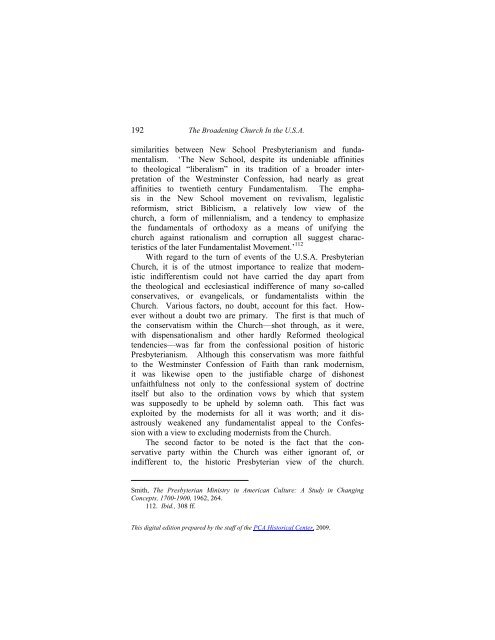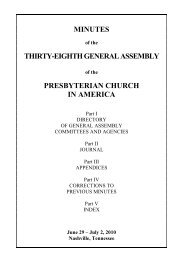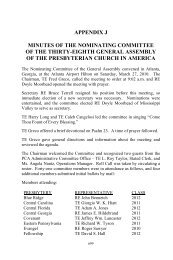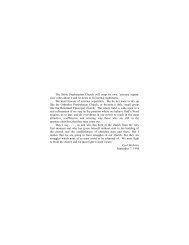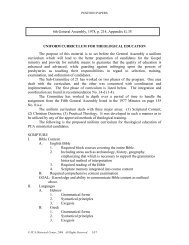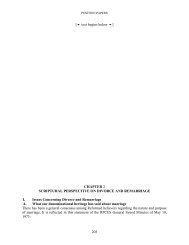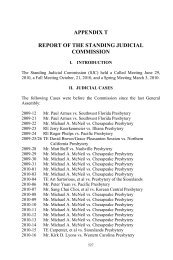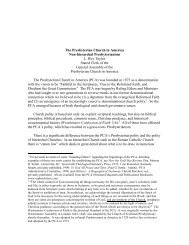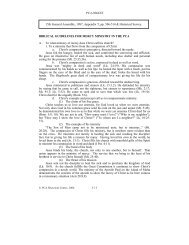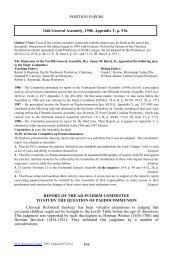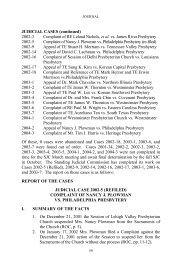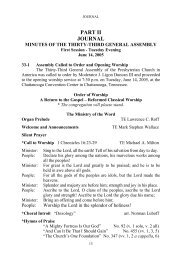Chapter 5: The Broadening Church in the USA - PCA Historical Center
Chapter 5: The Broadening Church in the USA - PCA Historical Center
Chapter 5: The Broadening Church in the USA - PCA Historical Center
You also want an ePaper? Increase the reach of your titles
YUMPU automatically turns print PDFs into web optimized ePapers that Google loves.
192 <strong>The</strong> <strong>Broaden<strong>in</strong>g</strong> <strong>Church</strong> In <strong>the</strong> U.S.A.similarities between New School Presbyterianism and fundamentalism.„<strong>The</strong> New School, despite its undeniable aff<strong>in</strong>itiesto <strong>the</strong>ological “liberalism” <strong>in</strong> its tradition of a broader <strong>in</strong>terpretationof <strong>the</strong> Westm<strong>in</strong>ster Confession, had nearly as greataff<strong>in</strong>ities to twentieth century Fundamentalism. <strong>The</strong> emphasis<strong>in</strong> <strong>the</strong> New School movement on revivalism, legalisticreformism, strict Biblicism, a relatively low view of <strong>the</strong>church, a form of millennialism, and a tendency to emphasize<strong>the</strong> fundamentals of orthodoxy as a means of unify<strong>in</strong>g <strong>the</strong>church aga<strong>in</strong>st rationalism and corruption all suggest characteristicsof <strong>the</strong> later Fundamentalist Movement.‟ 112With regard to <strong>the</strong> turn of events of <strong>the</strong> U.S.A. Presbyterian<strong>Church</strong>, it is of <strong>the</strong> utmost importance to realize that modernistic<strong>in</strong>differentism could not have carried <strong>the</strong> day apart from<strong>the</strong> <strong>the</strong>ological and ecclesiastical <strong>in</strong>difference of many so-calledconservatives, or evangelicals, or fundamentalists with<strong>in</strong> <strong>the</strong><strong>Church</strong>. Various factors, no doubt, account for this fact. Howeverwithout a doubt two are primary. <strong>The</strong> first is that much of<strong>the</strong> conservatism with<strong>in</strong> <strong>the</strong> <strong>Church</strong>—shot through, as it were,with dispensationalism and o<strong>the</strong>r hardly Reformed <strong>the</strong>ologicaltendencies—was far from <strong>the</strong> confessional position of historicPresbyterianism. Although this conservatism was more faithfulto <strong>the</strong> Westm<strong>in</strong>ster Confession of Faith than rank modernism,it was likewise open to <strong>the</strong> justifiable charge of dishonestunfaithfulness not only to <strong>the</strong> confessional system of doctr<strong>in</strong>eitself but also to <strong>the</strong> ord<strong>in</strong>ation vows by which that systemwas supposedly to be upheld by solemn oath. This fact wasexploited by <strong>the</strong> modernists for all it was worth; and it disastrouslyweakened any fundamentalist appeal to <strong>the</strong> Confessionwith a view to exclud<strong>in</strong>g modernists from <strong>the</strong> <strong>Church</strong>.<strong>The</strong> second factor to be noted is <strong>the</strong> fact that <strong>the</strong> conservativeparty with<strong>in</strong> <strong>the</strong> <strong>Church</strong> was ei<strong>the</strong>r ignorant of, or<strong>in</strong>different to, <strong>the</strong> historic Presbyterian view of <strong>the</strong> church.Smith, <strong>The</strong> Presbyterian M<strong>in</strong>istry <strong>in</strong> American Culture: A Study <strong>in</strong> Chang<strong>in</strong>gConcepts, 1700-1900, 1962, 264.112. Ibid., 308 ff.This digital edition prepared by <strong>the</strong> staff of <strong>the</strong> <strong>PCA</strong> <strong>Historical</strong> <strong>Center</strong>, 2009.


